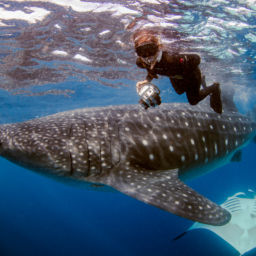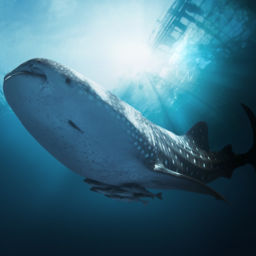In 2009, aerial images of the waters near the Mexican island of Isla Mujeres showed an expanse of clear, aquamarine blue flecked with hundreds of tiny brown dashes. On closer inspection, the dashes morphed into whale sharks, and the images provided photographic evidence of the largest aggregation ever recorded. That summer, a record 420 whale sharks were seen during a single flight, all within an area of just 11 square miles. Although whale-shark aggregations had been recorded elsewhere in the world, including in Mozambique, the Maldives, Honduras and Australia, the previous record was no more than a few dozen animals at once.
Located in the Caribbean Sea just off the northeastern tip of the Yucatan Peninsula, the waters of Isla Mujeres continue to play host to hundreds of whale sharks each year, in a phenomenon that scientists now think has been taking place for many years, despite its relatively recent scientific discovery in 2009.
[flo_gallery type=”single” name=”whale-sharks-of-isla” id=”6226″ ]
The whale sharks arrive in the area each year in early May and stay until mid-September. They are not the first whale shark aggregation to be recorded in the area; nearby Cabo Catoche also plays host to an annual gathering of the giant sharks, although in far fewer numbers. While the Cabo Catoche whale sharks come to feed on crustacean zooplankton in shallow, green water close to shore, the Isla Mujeres whale sharks are found in deep, blue water 20 to 30 miles away from the island. They are drawn there by the mass spawning of the little tunny, the most common tuna in the Atlantic Ocean, and spend the summer months voraciously feeding off the transparent fish eggs that coat the surface of the sea. Large numbers of manta rays, golden eagle rays, sailfish and even marlin join the whale sharks in the feast. Because this second, much larger concentration of whale sharks takes place further out to sea, local fishermen have given these whale sharks the collective name Afuera, or ‘outside’ in Spanish. For a long time, the fishermen were the only ones who knew about the Isla Mujeres sharks, until one of them mentioned the phenomenon to shark scientist Robert Hueter in 2002.
Since the fisherman’s 2002 revelation, surveys (first by boat and later by plane) have been conducted documenting the size of the newly discovered population, the proportion of males to females and the average size of separate individuals. Researchers found that the majority of the Isla Mujeres whale sharks were males, with females accounting for just 20 out of the 81 Afuera individuals tagged in 2009. Tagging of sharks at both the Afuera and Cabo Catoche aggregation sites showed that sharks tagged at Cabo Catoche often resurfaced later at Afuera, suggesting that the sharks are leaving Cabo Catoche for Isla Mujeres, possibly because of the sheer density of fish eggs found in Isla waters during the summer months. Scientists think the Isla food source may enable an individual shark to gain 2.5 times more energy during 8 hours of feeding than during the same period of time at Cabo Catoche. The studies conducted on the whale sharks of the Yucatan fall under the auspices of the Domino Project, a research and conservation program set up in 2003 by Mexico’s National Commission of Natural Protected Areas.
Research projects were not the only outcome of the aggregation’s discovery in 2002; since then, Isla Mujeres and neighboring Isla Holbox have become the epicenter for one of the fastest growing whale-shark tourism industries in the world. Two years ago, the Yucatan area already had 240 licensed whale-shark tour boats, which has some experts worrying that the sheer number of tourists in the water with the sharks may be putting them at risk. Concerns include the practicalities of increased boat traffic in an area where the whale sharks necessarily spend the majority of their time on the surface and the disruptive effect of countless spectators on the sharks’ feeding habits. However, in 2009 the Mexican government established the Whale Shark Biosphere Reserve, incorporating the Isla Mujeres aggregation site and protecting the sharks via a set of rules designed to regulate human-shark encounters. Each season has a set opening and closing date, outside of which it is illegal for tour boats to operate; visitors are not allowed to touch the whale sharks, and must stay more than 6.5 feet from them at all times. Tours cannot exceed a certain number of snorkelers and must be led by a guide; scuba is prohibited, as is flash photography.
Hopefully these rules will go some way to ensuring the future of this incredible annual phenomenon, in which snorkelers can encounter as many as 50 whale sharks during a single excursion. Despite the whale sharks’ enormity, getting in the water with them is perfectly safe (as long as due respect is paid to their powerful tail fins). Although a whale shark’s mouth can measure as much as 5 feet across, which enables them to siphon 1,500 gallons of water per hour, they pose no threat to humans. They are exceptionally docile, and have throats no bigger than the microscopic eggs and plankton that they feed on.
The whale shark is considered Vulnerable on the IUCN Red List and, as a species, needs all the help it can get. If conducted properly, the successful whale-shark tourism industry on Isla Mujeres and Isla Holbox could be a key to these magnificent animals’ conservation, as the acknowledgment of their financial worth will encourage both local and federal governments to enact protections.



